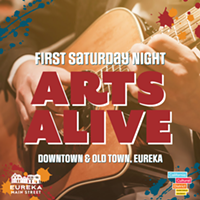Emotions and identity are tricky. They're even trickier when attempting to put them into words. It's one reason why art exists — it allows people to describe the human experience in ways that words don't, giving voice to the often conflicted, contradictory and complicated nature of living and being.
For artists Thaddeus Zoellner and Michael Royce, photography captures that which cannot be spoken. In particular, it reveals the ways in which they discover who they are and how they fit into the rest of the world. "How do you view yourself and feel OK being yourself?" asks Royce. Identity and emotions are topics they've both explored through black and white photography in their upcoming tandem show, "Whispered Secrets," a one-night-only show at C Street Gallery for Eureka's Arts! Alive on September 7th.
Both artists use the figure to explore the intersections of identity, gender and sexuality, and neither of them feels comfortable with the female/male, gay/straight, either/or dichotomies surrounding these categories. Royce and Zoellner use their own bodies, as well as those of friends, to create a different gender narrative — one that allows for a gray area in a culture that usually sees things as only black or white.
"I use my art to work through emotions that society tells us we may or may not be OK to feel," says Royce. When it comes to feeling like we don't fit in, we're told to "hide that, don't let anybody see it," she continues.
Royce's photographs are highly autobiographical, exploring the complexities surrounding past experiences. She resists explicitly defining the work, but states that her images are about uncovering and exhibiting the emotions many people choose to hide. Knowing there are others out there who don't fit into neat cultural boxes, she hopes "that other people will be able to connect [to her work] and think, 'Oh, I felt that way too.'" The emotional foundation of the work is hers, but the underlying struggle the work represents is widespread.
For example, when Royce uses herself as a model, she binds her chest with a wrap. For her, that's normal. That's how she envisions her body. The androgyny is not the focus of the images, but it does hint at their deeper messages. The binding can be seen as protective or constrictive, positive or negative, complicating familiar expectations and ideas about gender roles. It's a metaphor for the supposed freedom to be who you are and the accompanying risk of never being fully accepted or valued in our culture.
"Soulus" is a photograph that underscores the pain people can feel when they are outside of accepted norms. Royce is shown from the knees up, her head buried in her hands. Dramatic black droplets splatter around her. She's drawn wings by scratching into the photo through the black, resin-coated surface to expose the white paper below. Most striking though, are the cursive words "love you," burning through her torso. They are lit from behind by a light box, and the handwriting comes from a letter Royce received from a friend. There's a lot going on in this piece, and the intricacy of its layers pays honest homage to the thorny nature of understanding and accepting our true selves.
Accepting humanity's multifaceted nature is the thread that sews these two artists' work together. "Our work isn't part of the same sentence," chimes in Zoellner, "but it's part of the same paragraph."
Zoellner has long felt isolated in the way he views the world. Tall, blond and muscular, with a deliberate look in his blue eyes, his appearance is masculine. However, he doesn't "identify with being solely male or solely female. Or even androgynous." In many ways, he continues, "I identify as both male and female." Restrictive sexuality labels like gay, straight or bisexual don't work for him either, and these conflicts can create real turmoil.
Zoellner has given mental space to both sides of his persona, naming his feminine side Myra and allowing her to be who she wants to be. "She is frequently a silent passenger," he says, "but she's always there and she's always helping." When it comes to photography, Myra "has a lot of insight and opinions that the rest of me doesn't," admits Zoellner. "It's kind of a separate thought process."
For his last show, Zoellner created a set of prints that, when assembled, took him aback. It was the first time he'd produced something that came completely from Myra. "That show was Myra telling me she's there." In this new show, Zoellner is using both sides of his identity to tell everybody else that she's there. It's about defining his entire self and allowing both points of view to be on display.
In one multi-layered piece, "Who Holds Together", a dramatically-lit portrait of Zoellner's face has been ripped in half. Each side lies askew on top of a second photo of a nude female figure. She emerges confidently from his fractured visage, stretching a heavy chain in front of her chest. The chain provides a visual connection between the two torn halves, while a deeper reading reveals an allegorical reference to the strength and stability Myra brings to Zoellner's identity. Nested deep in a shadow-box frame, the viewer has to get close to the piece to see it, intensifying the intimacy of Zoellner's revelation.
Zoellner and Royce's work is intimate, yet the message of their work points out the universality of defining ourselves in a world that tries to do it for us. Their work asks us to explore those private emotions for a better understanding of how we fit into the wider world outside our bodies.




Comments